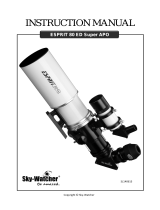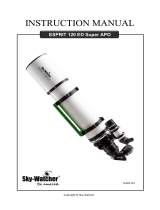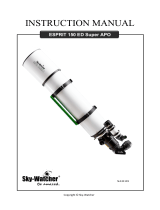Page is loading ...

Quattro 200 ST & CF Newtonian Astrograph
INSTRUCTION MANUAL
Copyright © Sky-Watcher
QT200-F-140618V1-EN

CONTENT
Part I : Introduction
Sky-Watcher Quattro-200 ST: Sky at Night magazine group test winner scoring 89% ....... 2
Part II: Getting Started
Parts description ................................................................................................................ 3
Assembling the finder scope .............................................................................................. 3
Frequently Asked Questions about the packaging ............................................................. 4
Doesn’t an astrograph deserve a better box than just a simple cardboard box? ................. 4
No eyepiece is provided with my telescope. Is it normal? .................................................. 4
Why is no coma corrector proposed as standard? ............................................................. 4
What does Sky-Watcher propose for the Quattro series as accessories? .......................... 4
Aligning the finder scope .................................................................................................... 5
Part III: Basic Operations
Using an eyepiece ............................................................................................................. 6
Using the 42x0.75mm ring (T2 ring) ................................................................................... 6
Using an accessory with specific connections .................................................................... 6
Focusing ............................................................................................................................ 7
Part IV: Advanced Operations
Offset and collimation ........................................................................................................ 8
Focuser parallelism ............................................................................................................ 9
Balancing the tube with a heavy image train ...................................................................... 9
Part V : Specifications
Telescope specifications ...................................................................................................11

Part I: Introduction
2
Part I : Introduction
Sky-Watcher Quattro-200 ST: Sky at Night magazine group test
winner scoring 89%
The superb Skywatcher Quattro-200 ST telescope OTA has beaten all the
opposition to win best in class in the November 2011 Sky at Night
magazine.
The most acclaimed feature of the Quattro 200
astrograph is the knife-edge baffle system. The
Quattro's tube is lined with a set of nine internal baffle
rings. Their main purpose is to cut down on stray light
entering the telescope tube, greatly helping to
improve image contrast.
The Quattro is fitted with a Crayford-style focuser with
tension adjustment, focus-lock and a 10:1 dual-speed
fine focusing, and also comes with a 2-inch fitting that
has a T-thread on its external side. This allows a
sturdy connection to be made between scope and
camera with the right adaptor ring.
The primary and secondary mirrors are made of Low
Expansion Borosilicate Glass, for near zero thermal
expansion.
The impressive 0.5 mm Ultra-Thin secondary mirror
vanes ensure minimal thermal accumulation and
reaches thermal equilibrium in no time.
The secondary mirror support is mounted offset, for
perfect optical collimation.
Optimized for astrophotography, with its baffle system and parabolic primary optics with a
very fast f/4 focal ratio, the Quattro 200 is designed for exceptional wide-field, deep-space
imaging performance. Even faint galaxies and nebulas exhibit stunning detail with limited
exposure time when photographed with a CCD imager or DSLR camera.
The Quattro 200 is proposed with two options for the tube: Standard Tube (ST series) and
Carbon Fiber (CF series) for astrophotographers dealing with long to very long exposure
times. The Carbon Fiber series can remain in focus for a longer period of time and long
exposure images will stay clear and in focus.
NEVER USE YOUR TELESCOPE TO LOOK DIRECTLY AT THE
SUN. PERMANENT EYE DAMAGE WILL RESULT.
NEVER USE AN EYEPIECE-TYPE SOLAR FILTER.
NEVER USE YOUR TELESCOPE TO PROJECT SUNLIGHT ONTO
ANOTHER SURFACE; THE INTERNAL HEAT BUILD-UP WILL
DAMAGE THE TELESCOPE OPTICAL ELEMENTS.
USE A PROPER SOLAR FILTER FIRMLY MOUNTED ON THE
FRONT OF THE TELESCOPE FOR VIEWING THE SUN.
WHEN OBSERVING THE SUN, PLACE A DUST CAP OVER
YOUR FINDERSCOPE OR REMOVE IT TO PROTECT YOU
FROM ACCIDENTAL EXPOSURE.
NEVER LET A TELESCOPE POINTING THE SUN UNATTENDED.

Part II: Getting Started
3
Part II: Getting Started
Parts description
When unpacking the box, you will find the following parts enclosed:
1. The main tube
2. 1 1/4 inch screwed on 42mm T2 adapter (left part (see Fig.2 page 6)) and 2 inch eyepiece
adapter (right part), to insert into the focuser's drawtube.
3. Finder bracket and 8x50 finder scope, with centering O-ring attached to the bracket.
4. Protective cap for the 1:10 speed reduction’s knob.
Assembling the finder scope
1. Carefully remove the rubber O-ring from the finder scope bracket. Position the O-ring into
the groove on the finder scope tube.
2. Loosen the two adjusting screws on the bracket. Position the finder scope into its bracket
by sliding it backwards until the rubber O-ring seats. The chrome button on the finder
bracket contains a spring. When inserting the finder scope in the bracket, pull the chrome
button.
Slide the finder scope bracket into the mounting slot on the telescope and tighten the screw
to hold the bracket in place

Part II: Getting Started
4
Frequently Asked Questions about the packaging:
Doesn’t an astrograph deserve a better box than just a simple cardboard box?
Yes, indeed. But when we asked seasoned astrophotographers what type of box should be
the best for a Newtonian astrograph, the answer was always the same: “Only a box I choose
specifically for my equipment will do the job”.
Because every astrophotographer we met has his own choice of camera, filter set, accessory
plate or even car trunk dimension we decide to let the customer free to choose what will be
the best fit instead of asking added money for a nice box which a vast majority will find
unpractical or even totally useless.
No eyepiece is provided with my telescope. Is it normal?
As the Quattro series are fast Newtonian astrograph we were unsure what can be the best
eyepiece to provide. Seasoned astrophotographers use different eyepieces for different
purposes: a standard low magnification eyepiece to check if the object is inside the field of
view, a high magnification eyepiece to observe Moon details and planets, and many more
usages were evoked.
Many astrophotographers already have eyepieces at hand so we decide to let any standard
eyepiece out of the box and to not ask money for an accessory most customers already have
at hand.
Why is no coma corrector proposed as standard?
A high quality coma corrector (see next paragraph) is an essential accessory for widefield
astrophotograpy. But the Quattro series can also offer nice visual images without coma
corrector.
Again we decide to let the coma corrector out of the box and let the customer decide what
will be the best fit.
What does Sky-Watcher propose for the Quattro series as accessories?
If you are looking for a great eyepiece to use with your telescope or other compatible
accessories, like the F4 Coma Corrector (4 lenses, enlarged T2 thread), we advise you to
ask your reseller or visit the Sky-Watcher sites at www.skywatcher.com or
ca.skywatcher.com for further inquiries.

Part II: Getting Started
5
Aligning the finder scope
The 8x50 finder scope is a small fixed magnification scope mounted on the optical tube.
When it is correctly aligned with the telescope, objects can be quickly located and brought to
the center of the field.
The alignment should be done at first use and over time if the alignment is no more accurate.
Alignment is best done outdoors in day light when it's easier to locate objects
If it is necessary to refocus your finder scope, look at
an object that is at least 500 meters (or yards) away.
Loosen the knurled ring by unscrewing it back
towards the bracket. The front lens holder can now
be turned in and out of focus. When focus is reached,
lock it in position with the knurled ring (Fig. 1).
NEVER LOOK DIRECTLY AT THE SUN WITH
THE FINDER SCOPE. IT COULD IMPAIR
DEFINITIVELY YOUR VISION.
When the finder scope is in focus, choose a distant object that is at least 500 meters (or
yards) away and point the main telescope at the object. Center the object in the eyepiece of
the telescope by aiming precisely at the distant object.
Now, check in the finder scope to see if that distant
object is exactly positioned behind the crosshairs of
the finder scope's eyepiece. If not, adjust the
alignment of the finder scope with the two black
adjusting screws on the bracket of the finder scope
(Fig. 2).
Do not over tighten the screws when aligning the
finder scope.
The image in the finder scope is upside-down. This is normal and has no
incidence on observations.

Part III: Basic Operations
6
Part III: Basic Operations
Using an eyepiece
1. Loosen the two thumbscrews on the focuser’s
drawtube [Fig 1.1].
2. Insert the 11/4 inches or 2 inches adapter
inside the focuser’ drawtube. Tighten the two
screws at the end of the focuser’s drawtube
[Fig 1.1], and unscrew the two thumbscrews
on the adapter [Fig 1.2a] or [Fig 1.2b].
3. Insert the eyepiece into the adapter [Fig 1.3a]
or [Fig 1.3b] and tighten the adapter’s
thumbscrews [Fig 1.2a] or [Fig 1.2b]
Using the 42x0.75mm ring (T2 ring)
The 11/4 inches adapter is composed of two parts:
an 11/4 inches tube [Fig 2.1] screwed on a T2
(42x0.75mm) plate [Fig 2.2].
To access the T2 ‘(42x0.75mm) plate [Fig 2.2]
simply unscrew the 11/4 inches tube [Fig 2.1] form
the 11/4 inches adapter.
Reassembling the 11/4 inches adapter can easily
be done by following the preceding steps in
reverse order.
1. Assemble the T2 plate with your T2 accessory
adapter [Fig 3.1].
2. Loosen the two thumbscrews on the focuser’s
drawtube [Fig 3.2].
3. Insert the T2 plate with your T2 accessory
adapter inside the focuser’s drawtube [Fig
3.3]. Tighten the two screws at the end of the
focuser’s drawtube [Fig 3.2].
4. Assemble your accessory onto the T2
accessory adapter [Fig 3.4].
Using an accessory with specific connections
[Fig. 4].Some accessories don’t need a standard
adapter to be connected to the telescope, like the
Sky-Watcher F4 Coma Corrector.
In this case please follow indications given with
the accessory for proper and secure connection.
Fig. 1
Fig. 2
Fig. 3
Fig. 4
Fig. 4

Part III: Basic Operations
7
Focusing
1. Make sure the locking screw [Fig 5.1] is loose.
2. Slowly turn the focus knobs [Fig 5.2] one way or the other,
until the image in the eyepiece is nearly sharp.
3. To finely focus the image turn the 1:10 knob one way or the
other until the image is perfectly sharp [Fig 5.3].
4. Tighten the locking screw [Fig 5.1] if a heavy load is
attached.
The image usually has to be finely refocused over time, due to
small variations caused by temperature changes. This often
happens when the telescope has not yet reached outside
temperature.
Refocusing is almost always necessary when you change an
eyepiece or accessory.
Fig. 5

Part IV: Advanced Operations
8
Part IV: Advanced Operations
Offset and collimation
The secondary mirror of the Quatto 200 is
already positioned “full offset”.
In a fast Newtonian like the Quattro, the center of
the secondary mirror doesn’t correspond to the
axis of the cone of light reflected by the primary
mirror. To intercept the light cone properly, the
secondary mirror has to be positioned “offset”
from its center, as shown in [Fig. 1].
The offset of the spider vanes with the center
of the secondary mirror will be visible when
looking into the telescope by the focuser's
side. This is normal and should be taken in
account when doing a collimation.
Mirrors inside the telescope have been carefully aligned to each other in the factory. When
using the telescope, this alignment should be checked to ensure optimal image quality.
When looking at a bright star, the star image given by your telescope should be symmetrical,
a central dot with diffraction rings centered on this white dot (see Fig 2). Be patient to
consider the average shape of the star image while the image is slowly moving due to air
turbulence (see Fig 3).
If the star image appears to be unsymmetrical (see Fig 4) a
recollimation is needed. Therefore, the blocking screws of
the primary mirror on the back of the telescope should be
loosened [Fig. 5.1] and the big adjustment knobs will then
allow realigning the primary mirror to obtain a symmetric star
image again [Fig. 5.2]. These adjustments should be small.
After adjusting, by tightening the blocking screws, you can
lock the primary mirror in its aligned position.
When misalignment is heavy, an alignment of the secondary
mirror should be done also. In that case, it is recommended
to use an optional laser collimator. This laser collimator
greatly helps in determining the misalignment of each mirror.
Fig. 1
Fig. 5

Part IV: Advanced Operations
9
Focuser parallelism
Since the Quattro Newtonian telescope is very well suited
for wide field photography, the focuser of this telescope is
equipped with adjustment screws for alignment of the
focuser to the optical axis of the telescope. Misalignment
can be detected in the edge of wide field pictures when
the stars in the 4 edges look different. The stars in the
edges may show some coma if the optional coma
corrector is not correcting all of the coma aberration in the
image edge of a very big size CCD, but this aberration
should be symmetric (all pointing to the center of the
image). If not, realigning the focuser with the push pull
screws ([Fig. 6 A and B]) may be needed.
FINE TUNING THE FOCUSER PARALLELISM IS A
DELICATE OPERATION. PLEASE CAREFULLY CHECK
FOR OTHER CAUSES BEFORE ATTEMPTING THIS
PROCEDURE.
Balancing the tube with a heavy image train
In Newtonian reflectors the secondary mirror intercepts the
light and points it out the side of the tube at right angles to
the tube through the eyepiece.
This configuration allows positioning the eyepiece in a
comfortable viewing angle, mainly parallel to the ground or
elevated some degrees when the target is low on horizon.
When using an accessory in the focuser, like an eyepiece,
the tube is not in perfect balance due to the added weight of
the eyepiece on one side of the tube. It has no real
importance when the accessory is light, the mount can
easily support such imbalance.
When using a heavy imaging train, containing a heavy CCD
camera, a radial guider, a filter wheel and maybe an adaptive
optic system the imbalance can become a real problem.
A neat solution to this imbalance problem is to put all the
imaging train vertically, oriented to the ground, as shown in
[Fig. 7].
IN THIS CONFIGURATION GRAVITY IS YOUR ENEMY! BE
CAREFUL TO PROPERLY SECURE YOUR ACCESSORIES
TO THE FOCUSER!
Fig. 6
Fig. 7

Part IV: Advanced Operations
10
When the imaging train is this
position you need to adjust the
focuser’s tension by using the
large thumbscrew below the
focuser, as shown in [Fig. 8]. A
correct tension allows to
smoothly focusing but doesn’t
let the imaging train move due
to gravity.
When in focus and centered
don’t forget to block the
focuser drawtube with the
thumbscrew placed on top, as
shown in [Fig. 9].
Fig. 8
Fig. 9

Part V: Specifications
11
Part V : Specifications
Telescope specifications
Optical Design
Newtonian Reflector
Aperture (mm)
205 mm (8 in)
Focal Length
800 mm (32 in)
Focal Ratio
4
Primary Mirror
Parabolic, Low Expansion Borosilicate Glass
Secondary Mirror
Flat, Low Expansion Borosilicate Glass
Central Obstruction
70mm, 34%
Tube Rings
With EQ5 dovetail plate
Highest Useful Magnification
400 x
Lowest Useful Magnification
29 x
Limiting Stellar Magnitude
13.4
Resolution (Rayleigh)
0.68 arc seconds
Resolution (Dawes)
0.59 arc seconds
Light Gathering Power
(Compared to Human Eye)
858 x
Fully Illuminated Field
44 mm (1.7 in)
Optical Tube Length
730 mm (28.74 in)
Optical Tube Weight ST Tube
9.5 kg (21 lbs)
Optical Tube Weight CF Tube
8.3 kg (17.7 lbs)
The focuser’s drawtube has a
maximum extension of 75mm from
the base. For specific applications,
requiring more than the standard
55mm back focus, it is possible to
machine a custom ring (thread
M54.5x1mm) to replace the 2 inch
accessory support and use it as a
base to affix specific accessories.
Please do note that the 75mm
drawtube course doesn’t mean
there is 75mm of free back focus.
Please do test there is enough
back focus for your configuration
before requesting a custom
made adaptation ring

12
We want to ensure that your experience with a Sky-
Watcher product is the best it can be. To make that
happen we have a comprehensive technical and
customer support available, alongside with the list of
distributors and dealers worldwide, on our worldwide
internet site:
http://www.skywatcher.com
Sky-Watcher offers this product with the best available quality in
accordance with the legislation of the local market, and reserves
the right to modify or discontinue, without prior notice to you,
any model or style telescope.
/





